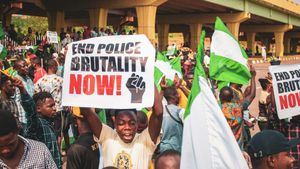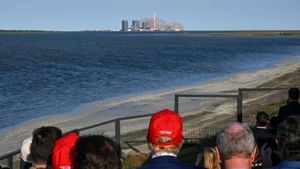A violent chaos erupted within the walls of Serbia’s National Assembly on Monday, as lawmakers engaged in fistfights amid fierce accusations stemming from the tragic collapse of a train station roof earlier this month. This incident has not only resulted in the deaths of 15 individuals but has also ignited deep-seated tensions between the ruling coalition and the opposition.
The clash came shortly after Prime Minister Miloš Vučević initiated discussions about the government’s budget for the year 2025. Opposition MPs, determined to shift focus to the disastrous building collapse, prominently displayed banners stating, "Your hands are bloody," explicitly accusing the government of responsibility. This backdrop of grief and anger set the stage for the upheaval.
The conflict escalated dramatically when Radomir Lazović, representing the opposition Green-Left Front party, attempted to deliver his message by brandishing imagery of a bloody handprint. This act caught the immediate ire of Health Minister Zlatibor Lončar, who reportedly confronted Lazović, inciting the larger brawl.
What followed was pandemonium, with video footage depicting MPs shoving and slapping each other, accompanied by boos and shouts. Some lawmakers even resorted to throwing water across the chamber, all the chaos happening under the distressed supervision of the parliament speaker, Ana Brnabić, who struggled to maintain order, labeling the scene as "a shame for this house."
The turmoil in parliament mirrors the broader public sentiment following the horrific incident on November 1, when the station roof collapse occurred during renovation efforts. Critics have pointed at systemic issues, highlighting allegations of rampant corruption and gross negligence concerning safety regulations and construction quality. This incident, as many have claimed, is indicative of the deteriorated oversight plaguing Serbia's infrastructure projects.
Protests erupted not long after the incident, as citizens took to the streets expressing their outrage over the government’s handling of the tragedy. An estimated 20,000 demonstrators rallied, painting their hands red to symbolize the blood they believe is on the government's hands. This movement has called for accountability and clearer transparency concerning governmental activities.
The judiciary has begun to respond to public outcry. A total of 12 individuals have been arrested, including Serbia's former construction minister, Goran Vesic, who resigned shortly after the incident. Despite the charges being levied against him, Vesic has publicly denied culpability, asserting, “I cannot accept guilt for the deaths, because I and the people who work with me have not an ounce of responsibility for the tragedy.”
This incident and the subsequent parliamentary brawl are imperatively intertwined with critiques of President Aleksandar Vučić’s government, which opposition figures and critics claim has increasingly centralized power and heightened authoritarianism. Notably, the atmosphere of chaos isn’t just confined to the halls of power but has manifested as growing dissatisfaction among the populace over the governance style, demanding thorough reforms and oversight of public projects.
The backlash against the government is underscored by statements made by opposition leader Dragan Djilas, who condemned the parliamentary speaker for refusing to table the opposition's proposal for discussing the tragedy. Djilas expressed, “She started with when she refused to put on the agenda the request of more than 80 members of the opposition for a debate on confidence in the government because of the murder and crime in Novi Sad.”
The specter of the train station disaster continues to resonate throughout Serbian society, as citizens grapple with grief and anger laced with demands for accountability. The infrastructure problems and their decay have came to represent not just physical but political pitfalls, stirring echoes of calls for systemic change.
Moving forward, the current governmental narrative attempts to frame the opposition's actions as politically motivated chaos, neglecting the legitimate grievances of the public. President Vučić characterized the situation as daily bullying and savage behavior, vowing to counter such provocations with dedication to work. Such rhetoric only serves to deepen the divides within the nation’s political discourse.
This tumultuous environment reflects the high-stakes power struggle and underline the fragile state of Serbia’s democracy. The train station catastrophe has catalyzed not just scrutiny, but also demonstrations fueling demands for comprehensive actions against systemic corruption. With heightened discontent among citizens, the government faces pressure to address the failures leading up to the disaster, as the political dynamics continue to evolve bafflingly amid the pandemonium and outcries for justice.



